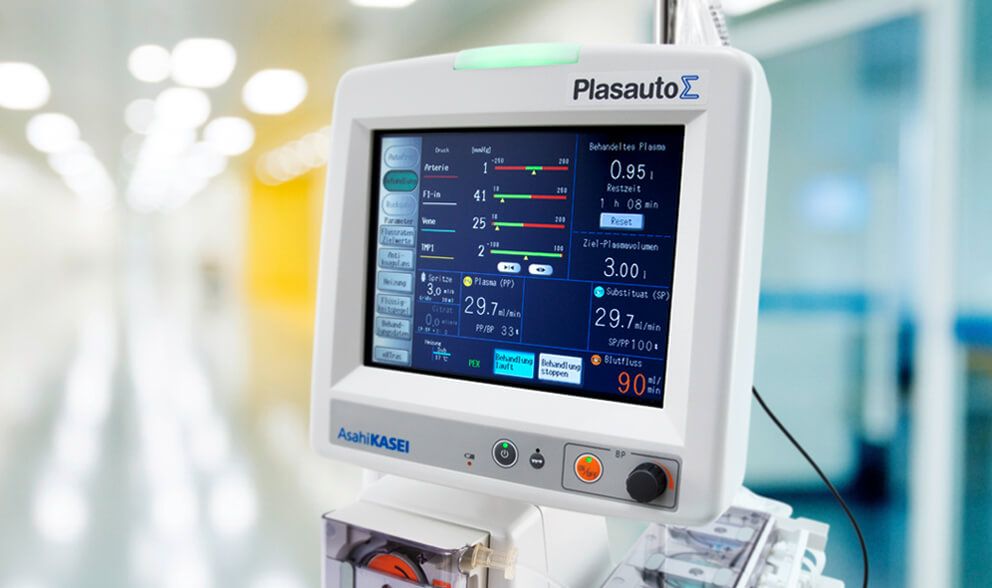Multimodal hemoadsorption for sepsis and septic shock
HematoPure Duo is an innovative extracorporeal hemoadsorption procedure that has been specially developed for intensive care and emergency medicine. An important component of HematoPure Duo is the MDR-certified Efferon LPS adsorber. This offers a targeted solution for the treatment of sepsis - one of the most common causes of death worldwide, which can quickly become life-threatening if left untreated.
Combined strength: two therapies in one adsorber
HematoPure Duo sets a new standard with Efferon-LPS by combining two different therapeutic approaches in just one adsorber for the first time. Key pathogenic substance classes, such as endotoxins and excess inflammatory mediators, including cytokines, are selectively and simultaneously bound to the unique adsorber polymer surface.
Indications include:
- Sepsis and septic shock
- Critical endotoxemia, elevated endotoxin levels in the blood (extracorporeal endotoxin adsorption)
- Cytokine storm, elevated cytokine levels in the blood (extracorporeal cytokine adsorption)
Multiple and simple integration options
Easy integration into existing extracorporeal systems makes HematoPure Duo an innovative total solution for the treatment of sepsis and septic shock:
- RRT (renal replacement therapy)
- CPB (cardiopulmonary bypass)
- ECMO (extracorporeal membrane oxygenation)
- Hemoadsorption
The multimodal mode of action
Major pathogenic substance classes are selectively and simultaneously bound by HematoPure Duo. These include, for example, endotoxins and excess inflammatory mediators such as cytokines.

Multimodal hemoadsorption for sepsis and septic shock
The clinical efficacy of HematoPure Duo is supported by the results of a multicenter, randomized, controlled trial published by Rey et al. in the journal SHOCK 2023. The study included patients with abdominal sepsis and septic shock. The intervention group, which received hemoadsorption with Efferon LPS twice in addition to standard treatment, showed clinically relevant improvements.
Results of a multicenter randomized controlled trial confirm efficacy
- 58 patients with abdominal sepsis and septic shock were included (2:1 randomization). The control group (n=20) received standard treatment, the intervention group (n=38) received standard treatment plus two hemoadsorptions (HA) with the Efferon LPS adsorber.
- The primary endpoint was the resolution of septic shock and the associated restoration of hemodynamic stability.
Rey et al. SHOCK (2023) 59, 846-854.
Outcome: clinically relevant improvement after two treatments
Concerning the hemodynamic parameters, a significant increase in mean arterial blood pressure (MAP) and a reduced vasopressor requirement were observed after just 24 hours. In addition, the time to restore hemodynamic stability and to stop vasopressor administration was significantly shorter. Overcoming septic shock was achieved by 26 out of 38 patients in the intervention group compared to 9 out of 20 patients in the control group.

With regard to respiration, shorter ventilation times and a higher proportion of successful weaning (21 out of 37 patients vs. 5 out of 17 patients) were observed. The PaO2/FiO2 value also increased from 24 hours after the start of treatment. In terms of renal function, both creatinine levels and the need for renal replacement therapy decreased. Multi-organ dysfunction showed a significant reduction in the SOFA score (sequential organ failure assessment) after 72 hours from 7 to 3 points in the hemoadsorption group. In addition, biomarkers of systemic inflammation such as PCT, CRP and IL-6 were reduced. The LPS value was reduced in 75% of patients.
Respiration
- Shorter ventilation times (MV5 median 2.6 d vs. 4.8 d)
- Successful weaning 21/37 vs. 5/17 of patients
- Increase in PaO2/FiO2 (with onset after 24 h)
Renal function
- Creatinine and RRT6 requirement decreases
4MAP = mean arterial blood pressure; 5MV = mechanical ventilation; 6RRT = renal replacement therapy

Would you like to find out more about our products and solutions?
Get in contactPlasauto SIGMA device technology
Plasauto SIGMA - the market leader from Japan - for continuous renal replacement therapy and therapeutic apheresis. Suitable even for the youngest and smallest patients! Whether citrate or heparin, outpatient or inpatient - the choice is yours!


Therapy solutions for healthcare professionals
Are you interested in other apheresis procedures?
The following information is intended for healthcare professionals only.
The information in the section ‚products & therapies‘ is intended to provide explanatory, scientific, and evidence-based answers to medical questions about therapeutic apheresis.
This information does not constitute medical advice. The responsibility for patient care rests with the healthcare professional based on their professional licensure, experience, and knowledge of the patient.



